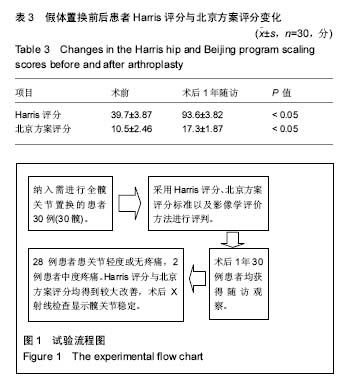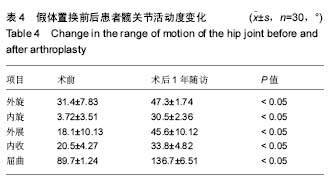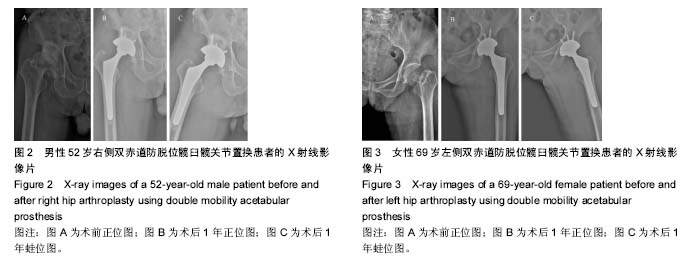| [1] 戴繁林,张鹏,黄晓华,等. 人工全髋关节置换术中后方软组织不同处理方式对术后假体脱位的影响[J]. 中国骨与关节损伤杂志, 2015, 30(10): 1013-1016.[2] 李朋,朱智奇,侯明,等. Zweymüller SLR-Plus®非骨水泥柄用于髋关节翻修的中期效果[J]. 中国组织工程研究, 2014, 18(35): 5600-5605.[3] 郭瑞峰.全髋关节置换术后脱位原因及防治[J]. 中国实用医刊, 2010, 37(3):24-26.[4] Langlois J, Hage SE, Hamadouche M. Intraprosthetic dislocation: a potentially serious complication of dual mobility acetabular cups. Skeletal Radiol. 2014;43(7):1013-1016.[5] Babis GC, Sakellariou VI, O'Connor MI, et al. Proximal femoral allograft-prosthesis composites in revision hip replacement: a 12-year follow-up study. Bone Joint J. 2010; 92(3):349-355.[6] 张明,袁振.人工髋关节置换的假体选择:人工全髋关节聚乙烯内衬的特点及搭配[J]. 山东医药, 2011, 51(19):106-107.[7] 李强.陶瓷对陶瓷人工髋关节的磨擦界面特征[J]. 中国组织工程研究, 2013, 17(17):3184-3191.[8] 姚进.不同材料髋关节假体在髋关节置换中的应用[J]. 中国组织工程研究, 2011, 15(17):3196-3199.[9] 吴海山,冯明光.髋膝关节置换术后疗效评估体系[J]. 中华骨科杂志, 2004, 24(8):509-512.[10] 祝天经.人工髋关节置换手术的疗效评定及功能评定[J]. 现代康复, 2001, 5(6):11-13.[11] 蒋协远,王大伟. 骨科临床疗效评价标准(精)[M]. 北京:人民卫生出版社, 2007.[12] 董凡,王以友.三种髋关节功能评定方法的比较研究[J]. 中华外科杂志, 1994, 32(9):535-538.[13] Mahomed NN, Arndt DC, Mcgrory BJ, et al. The Harris hip score: comparison of patient self-report with surgeon assessment. J Arthroplasty. 2001;16(5):575-580.[14] Söderman P, Malchau H. Is the Harris hip score system useful to study the outcome of total hip replacement? Clin Orthop Relat Res. 2001;384(384):189-197.[15] 吴丽. CT影像在固定治疗骶髋关节脱位中的临床应用分析[J]. 中国实用医药, 2016, 11(2):53-54.[16] 冯明利,沈惠良,曹光磊,等. 人工髋关节置换术治疗髋部骨折内固定失败的临床研究[J]. 中国骨与关节损伤杂志, 2014, 29(2): 121-123.[17] Banaszkiewicz PA. Total Hip Replacement in Patients Younger Than Thirty Years Old: A Five-Year Follow-Up Study. J Bone Joint Surg Am. 2014;63(9):1426-1434.[18] 贺永进,李长红,刘志斌,等.全髋关节置换术治疗 Crowe Ⅳ型髋关节发育不良的疗效观察[J].湖南师范大学学报:医学版,2016, 13(1):131-133.[19] 梁芳慧, 刘忠良, 李敬,等. 生物固定型双赤道防脱位髋臼假体[P]. 中国专利:CN201668540U, 2010-12-15.[20] 彭昊,陈森,郑慧锋,等. 生物型假体全髋关节置换术治疗成人髋关节发育不良继发骨关节炎的疗效评价[J]. 中国矫形外科杂志, 2013, 21(15):1502-1507.[21] Kobayashi S, Saito N, Nawata M, et al. Total hip arthroplasty with bulk femoral head autograft for acetabular reconstruction in DDH. Surgical technique. J Bone Joint Surg Am.2004;86-A Suppl 1:11-17.[22] Paliwal M, Allan DG, Filip P. Retrieval Analysis of a Cementless Modular Total Hip Arthroplasty Prosthesis[C]// IEEE International Conference on Bioinformatics and Bioengineering. IEEE, 2007:553-558.[23] 孙俊英,郝跃峰,杨沛彦,等.采用羟基磷灰石涂层股骨柄假体行全髋置换术的早期疗效[J]. 中华创伤骨科杂志, 2006, 8(1):27-30.[24] Paulsen A, Pedersen AB, Johnsen SP, et al. Effect of hydroxyapatite coating on risk of revision after primary total hip arthroplasty in younger patients: findings from the Danish Hip Arthroplasty Registry. Acta Orthopaedica Scandinavica. 2007;78(5):622-628.[25] 赵凤朝,李子荣.髋关节置换术后假体脱位的预防[J]. 中国矫形外科杂志, 2009, 17(9):674-676.[26] 谢士成,张玉革,王元吉,等.人工髋关节置换术后翻修的原因分析及假体选择[J]. 中华全科医学, 2013, 11(6):861-862.[27] 李静东, 郝立波, 王岩,等. 临时假体在人工髋关节置换术后感染治疗中的初步应用[J]. 中国矫形外科杂志, 2005, 13(14): 1076-1078.[28] 张峡,任先军,周跃,等. 定制抗生素骨水泥临时假体在人工髋关节置换术后感染二期翻修中的应用[J]. 中国骨与关节损伤杂志, 2006, 21(10):772-774.[29] 袁宏, 王利, 赵喜滨,等. 关节型抗生素骨水泥临时替代假体治疗膝关节置换术后深部感染[J]. 中华关节外科杂志电子版, 2009, 3(6):69-71.[30] Mirza AJ, Jr LA, Morris MJ, et al. A mini-anterior approach to the hip for total joint replacement: optimising results: improving hip joint replacement outcomes. Bone Joint J. 2014;96-B(11 Supple A):32-35.[31] Rudin D, Manestar M, Ullrich O, et al. The Anatomical Course of the Lateral Femoral Cutaneous Nerve with Special Attention to the Anterior Approach to the Hip Joint. J Bone Joint Surg. 2016;98(7):561-567.[32] 曾义高,杜杏利,王向东,等. 新型髋关节假体行全髋关节置换术后近期疗效分析[J]. 生物骨科材料与临床研究, 2013, 10(3): 26-29. |
.jpg)



.jpg)
.jpg)